rlTRPOAgent
Description
Trust region policy optimization (TRPO) is an on-policy, policy gradient reinforcement learning method for environments with a discrete or continuous action space. It directly estimates a stochastic policy and uses a value function critic to estimate the value of the policy. This algorithm prevents significant performance drops compared to standard policy gradient methods by keeping the updated policy within a trust region close to the current policy. The action space can be either discrete or continuous. For continuous action spaces, this agent does not enforce constraints set in the action specification; therefore, if you need to enforce action constraints, you must do so within the environment.
Note
For TRPO agents, you can only use actors or critics with deep network that support calculating higher order derivatives. Actors and critics that use recurrent networks, custom basis functions, or tables are not supported.
For more information on TRPO agents, see Trust Region Policy Optimization (TRPO) Agent. For more information on the different types of reinforcement learning agents, see Reinforcement Learning Agents.
Creation
Syntax
Description
Create Agent from Observation and Action Specifications
agent = rlTRPOAgent(observationInfo,actionInfo)observationInfo and the action
specification actionInfo. The ObservationInfo
and ActionInfo properties of agent are set to
the observationInfo and actionInfo input
arguments, respectively.
agent = rlTRPOAgent(observationInfo,actionInfo,initOpts)initOpts object. TRPO agents do not support recurrent neural
networks. For more information on the initialization options, see rlAgentInitializationOptions.
Create Agent from Actor and Critic
Specify Agent Options
agent = rlTRPOAgent(___,agentOptions)agentOptions input argument. Use this syntax after
any of the input arguments in the previous syntaxes.
Input Arguments
Agent initialization options, specified as an rlAgentInitializationOptions object.
TRPO agents do not support recurrent neural networks. Therefore
initOpts.UseRNNmust be false.
Actor that implements the policy, specified as an rlDiscreteCategoricalActor or rlContinuousGaussianActor function approximator object. For more
information on creating actor approximators, see Create Policies and Value Functions.
Critic that estimates the discounted long-term reward, specified as an rlValueFunction
object. For more information on creating critic approximators, see Create Policies and Value Functions.
Properties
Observation specifications, specified as an rlFiniteSetSpec
or rlNumericSpec
object or an array containing a mix of such objects. Each element in the array defines
the properties of an environment observation channel, such as its dimensions, data type,
and name.
If you create the agent by specifying an actor or critic, the value of
ObservationInfo matches the value specified in the actor and
critic objects. If you create a default agent, the agent constructor function sets the
ObservationInfo property to the input argument
observationInfo.
You can extract observationInfo from an existing environment,
function approximator, or agent using getObservationInfo. You can also construct the specifications manually
using rlFiniteSetSpec
or rlNumericSpec.
Example: [rlNumericSpec([2 1])
rlFiniteSetSpec([3,5,7])]
Action specifications, specified either as an rlFiniteSetSpec
(for discrete action spaces) or rlNumericSpec
(for continuous action spaces) object. This object defines the properties of the
environment action channel, such as its dimensions, data type, and name.
Note
For this agent, only one action channel is allowed.
If you create the agent by specifying an actor and critic, the value of
ActionInfo matches the value specified in the actor and critic
objects. If you create a default agent, the agent constructor function sets the
ActionInfo property to the input argument
ActionInfo.
You can extract actionInfo from an existing environment, function
approximator, or agent using getActionInfo. You can also construct the specification manually using
rlFiniteSetSpec
or rlNumericSpec.
Example: rlNumericSpec([2 1])
Agent options, specified as an rlTRPOAgentOptions object.
Option to use an exploration policy when selecting actions during simulation or after deployment, specified as a logical value.
true— Specify this value to use the base agent exploration policy when you use the agent with thesimandgeneratePolicyFunctionfunctions. Specifically, in this case, the agent uses therlStochasticActorPolicyobject with theUseMaxLikelihoodActionproperty set tofalse. The agent selects its actions by sampling its probability distribution, so the policy is stochastic and the agent explores its action and observation spaces.false— Specify this value to force the agent to use the base agent greedy policy (the action with maximum likelihood) when you use the agent with thesimandgeneratePolicyFunctionfunctions. Specifically, in this case, the agent uses therlStochasticActorPolicypolicy with theUseMaxLikelihoodActionproperty set totrue. The agent selects its actions greedily, so the policy behaves deterministically and the agent does not explore its action and observation spaces.
Note
This option affects only simulation and deployment and does not affect training.
When you train an agent using the train
function, the agent always uses its exploration policy independently of the value of
this property.
Sample time of the agent, specified as a positive scalar or as -1.
Within a MATLAB® environment, the agent is executed every time the environment advances,
so, SampleTime does not affect the timing of the agent execution.
If SampleTime is set to -1, in MATLAB environments, the time interval between consecutive elements in the
returned output experience is considered equal to 1.
Within a Simulink® environment, the RL Agent block
that uses the agent object executes every SampleTime seconds of
simulation time. If SampleTime is set to -1 the
block inherits the sample time from its input signals. Set
SampleTime to -1 when the block is a child
of an event-driven subsystem.
Set SampleTime to a positive scalar when the block is not a child
of an event-driven subsystem. Doing so ensures that the block executes at appropriate
intervals when input signal sample times change due to model variations. If
SampleTime is a positive scalar, this value is also the time
interval between consecutive elements in the output experience returned by sim or
train,
regardless of the type of environment.
If SampleTime is set to -1, in Simulink environments, the time interval between consecutive elements in the
returned output experience reflects the timing of the events that trigger the RL Agent block
execution.
This property is shared between the agent and the agent options object within the agent. If you change this property in the agent options object, it also changes in the agent, and vice versa.
Example: SampleTime=-1
Object Functions
train | Train reinforcement learning agents within a specified environment |
sim | Simulate trained reinforcement learning agents within specified environment |
getAction | Obtain action from agent, actor, or policy object given environment observations |
getActor | Extract actor from reinforcement learning agent |
setActor | Set actor of reinforcement learning agent |
getCritic | Extract critic from reinforcement learning agent |
setCritic | Set critic of reinforcement learning agent |
generatePolicyFunction | Generate MATLAB function that evaluates policy of an agent or policy object |
Examples
Create an environment and obtain its observation and action specifications. For this example, load the environment used in the example Create DQN Agent Using Deep Network Designer and Train Using Image Observations. This environment has two observations: a 50-by-50 grayscale image and a scalar (the angular velocity of the pendulum). The action is a scalar with five possible elements (a torque of -2, -1, 0, 1, or 2 Nm applied to a swinging pole).
% Load predefined environment env = rlPredefinedEnv("SimplePendulumWithImage-Discrete");
Obtain the observation and action specifications for this environment.
obsInfo = getObservationInfo(env); actInfo = getActionInfo(env);
The agent creation function initializes the actor and critic networks randomly. Ensure reproducibility of the section by fixing the seed of the random generator.
rng(0)
Create a TRPO agent from the environment observation and action specifications. Since actInfo is an rlFiniteSetSpec object, rlTRPOAgent creates an agent with a discrete action space. When actInfo is an rlNumericSpec object, rlTRPOAgent creates an agent with a continuous action space.
agent = rlTRPOAgent(obsInfo,actInfo);
To check your agent, use getAction to return the action from a random observation.
getAction(agent,{rand(obsInfo(1).Dimension),rand(obsInfo(2).Dimension)})ans = 1×1 cell array
{[-2]}
You can now test and train the agent within the environment.
Create an environment and obtain its observation and action specifications. For this example, load the environment used in the example Train DDPG Agent to Swing Up and Balance Pendulum with Image Observation. This environment has two observations: a 50-by-50 grayscale image and a scalar (the angular velocity of the pendulum). The action is a scalar representing a torque ranging continuously from -2 to 2 Nm.
env = rlPredefinedEnv("SimplePendulumWithImage-Continuous");Obtain observation and action specifications for this environment.
obsInfo = getObservationInfo(env); actInfo = getActionInfo(env);
Create an agent initialization options object, specifying that each hidden fully connected layer in the network must have 128 neurons. TRPO agents do not support recurrent networks, so setting the UseRNN option to true generates an error when the agent is created.
initOpts = rlAgentInitializationOptions(NumHiddenUnit=128);
The agent creation function initializes the actor and critic networks randomly. Ensure reproducibility of the section by fixing the seed of the random generator.
rng(0)
Create a TRPO agent from the environment observation and action specifications using the specified initialization options. Since actInfo is an rlNumericSpec object, rlTRPOAgent creates an agent with a continuous action space. When actInfo is an rlFiniteSetSpec object, rlTRPOAgent creates an agent with a discrete action space.
agent = rlTRPOAgent(obsInfo,actInfo,initOpts);
Extract the deep neural networks from both the agent actor and critic.
actorNet = getModel(getActor(agent)); criticNet = getModel(getCritic(agent));
To verify that each hidden fully connected layer has 128 neurons, you can display the layers on the MATLAB® command window,
criticNet.Layers
or visualize the structure interactively using analyzeNetwork.
analyzeNetwork(criticNet)
Plot the critic and actor networks.
plot(criticNet)
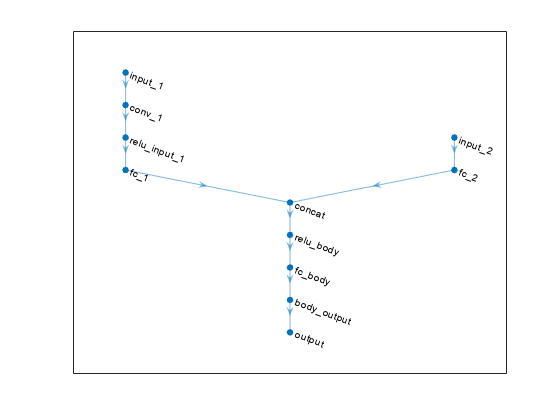
plot(actorNet)
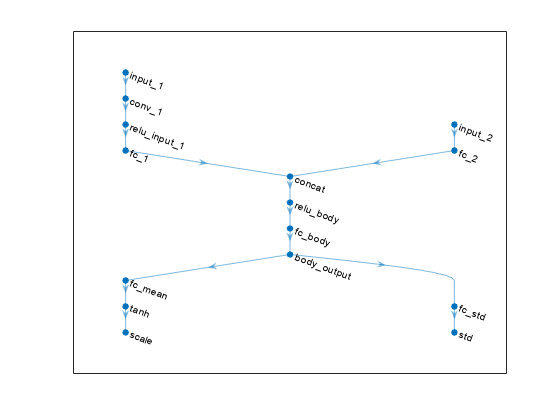
To check your agent, use getAction to return the action from a random observation.
getAction(agent,{rand(obsInfo(1).Dimension),rand(obsInfo(2).Dimension)})ans = 1×1 cell array
{[0.9228]}
You can now test and train the agent within the environment.
Create an environment object, and obtain its observation and action specifications.
env = rlPredefinedEnv("CartPole-Discrete");
obsInfo = getObservationInfo(env);
actInfo = getActionInfo(env);TRPO agents use a parametrized value function approximator to estimate the value of the policy. A value-function critic takes the current observation as input and returns a single scalar as output (the estimated discounted cumulative long-term reward for following the policy from the state corresponding to the current observation).
To model the parametrized value function within the critic, use a neural network with one input layer (which receives the content of the observation channel, as specified by obsInfo) and one output layer (which returns the scalar value). Note that prod(obsInfo.Dimension) returns the total number of dimensions of the observation space regardless of whether the observation space is a column vector, row vector, or matrix.
Define the network as an array of layer objects.
criticNet = [
featureInputLayer(prod(obsInfo.Dimension))
fullyConnectedLayer(100)
reluLayer
fullyConnectedLayer(1)
];Convert to a dlnetwork object and display the number of parameters.
criticNet = dlnetwork(criticNet); summary(criticNet)
Initialized: true
Number of learnables: 601
Inputs:
1 'input' 4 features
Create the critic approximator object using criticNet and the observation specification. For more information on value function approximators, see rlValueFunction.
critic = rlValueFunction(criticNet,obsInfo);
Check the critic with a random observation input.
getValue(critic,{rand(obsInfo.Dimension)})ans = single
-0.2479
TRPO agents use a parametrized stochastic policy, which for discrete action spaces is implemented by a discrete categorical actor. This actor takes an observation as input and returns as output a random action sampled (among the finite number of possible actions) from a categorical probability distribution.
To model the parametrized policy within the actor, use a neural network with one input layer (which receives the content of the environment observation channel, as specified by obsInfo) and one output layer. The output layer must return a vector of probabilities for each possible action, as specified by actInfo. Note that numel(actInfo.Dimension) returns the number of possible actions.
Define the network as an array of layer objects.
actorNet = [
featureInputLayer(prod(obsInfo.Dimension))
fullyConnectedLayer(200)
reluLayer
fullyConnectedLayer(numel(actInfo.Dimension))
];Convert to a dlnetwork object and display the number of parameters.
actorNet = dlnetwork(actorNet); summary(actorNet)
Initialized: true
Number of learnables: 1.4k
Inputs:
1 'input' 4 features
Create the actor using actorNet and the observation and action specifications. For more information on discrete categorical actors, see rlDiscreteCategoricalActor.
actor = rlDiscreteCategoricalActor(actorNet,obsInfo,actInfo);
Check the actor with a random observation input.
getAction(actor,{rand(obsInfo.Dimension)})ans = 1×1 cell array
{[-10]}
Create a TRPO agent using the actor and the critic.
agent = rlTRPOAgent(actor,critic)
agent =
rlTRPOAgent with properties:
AgentOptions: [1×1 rl.option.rlTRPOAgentOptions]
UseExplorationPolicy: 1
ObservationInfo: [1×1 rl.util.rlNumericSpec]
ActionInfo: [1×1 rl.util.rlFiniteSetSpec]
SampleTime: 1
Specify agent options, including training options for the actor and the critic.
agent.AgentOptions.ExperienceHorizon = 1024; agent.AgentOptions.DiscountFactor = 0.95; agent.AgentOptions.CriticOptimizerOptions.LearnRate = 8e-3; agent.AgentOptions.CriticOptimizerOptions.GradientThreshold = 1;
Check your agent with a random observation input.
getAction(agent,{rand(obsInfo.Dimension)})ans = 1×1 cell array
{[-10]}
You can now test and train the agent against the environment.
Create an environment with a continuous action space, and obtain its observation and action specifications. For this example, load the double-integrator continuous action space environment used in the example Compare DDPG Agent to LQR Controller. The observation from the environment is a vector containing the position and velocity of a mass. The action is a scalar representing a force applied to the mass, ranging continuously from -2 to 2 Newton.
env = rlPredefinedEnv("DoubleIntegrator-Continuous");
obsInfo = getObservationInfo(env)obsInfo =
rlNumericSpec with properties:
LowerLimit: -Inf
UpperLimit: Inf
Name: "states"
Description: "x, dx"
Dimension: [2 1]
DataType: "double"
actInfo = getActionInfo(env)
actInfo =
rlNumericSpec with properties:
LowerLimit: -Inf
UpperLimit: Inf
Name: "force"
Description: [0×0 string]
Dimension: [1 1]
DataType: "double"
In this example, the action is a scalar value representing a force ranging from -2 to 2 Newton. To make sure that the output from the agent is in this range, you perform an appropriate scaling operation. Store these limits so you can easily access them later.
actInfo.LowerLimit=-2; actInfo.UpperLimit=2;
The actor and critic networks are initialized randomly. Ensure reproducibility of the section by fixing the seed of the random generator.
rng(0)
TRPO agents use a parametrized value function approximator to estimate the value of the policy. A value-function critic takes the current observation as input and returns a single scalar as output (the estimated discounted cumulative long-term reward for following the policy from the state corresponding to the current observation).
To model the parametrized value function within the critic, use a neural network with one input layer (which receives the content of the observation channel, as specified by obsInfo) and one output layer (which returns the scalar value). Note that prod(obsInfo.Dimension) returns the total number of dimensions of the observation space regardless of whether the observation space is a column vector, row vector, or matrix.
Define the network as an array of layer objects.
criticNet = [
featureInputLayer(prod(obsInfo.Dimension))
fullyConnectedLayer(100)
reluLayer
fullyConnectedLayer(1)
];Convert to a dlnetwork object, initialize it and display the number of parameters.
criticNet = dlnetwork(criticNet); criticNet = initialize(criticNet); summary(criticNet)
Initialized: true
Number of learnables: 401
Inputs:
1 'input' 2 features
Create the critic approximator object using criticNet and the observation specification. For more information on value function approximators, see rlValueFunction.
critic = rlValueFunction(criticNet,obsInfo);
Check the critic with a random observation input.
getValue(critic,{rand(obsInfo.Dimension)})ans = single
-0.0899
TRPO agents use a parametrized stochastic policy, which for continuous action spaces is implemented by a continuous Gaussian actor. This actor takes an observation as input and returns as output a random action sampled from a Gaussian probability distribution.
To approximate the mean values and standard deviations of the Gaussian distribution, you must use a neural network with two output layers, each having as many elements as the dimension of the action space. One output layer must return a vector containing the mean values for each action dimension. The other must return a vector containing the standard deviation for each action dimension.
Note that standard deviations must be nonnegative and mean values must fall within the range of the action. Therefore the output layer that returns the standard deviations must be a softplus or ReLU layer, to enforce nonnegativity, while the output layer that returns the mean values must be a scaling layer, to scale the mean values to the output range.
For this example the environment has only one observation channel and therefore the network has only one input layer.
Define each network path as an array of layer objects, and assign names to the input and output layers of each path. These names allow you to connect the paths and then later explicitly associate the network input and output layers with the appropriate environment channel.
% Define common input path layer commonPath = [ featureInputLayer(prod(obsInfo.Dimension),Name="comPathIn") fullyConnectedLayer(100) reluLayer fullyConnectedLayer(1,Name="comPathOut") ]; % Define mean value path meanPath = [ fullyConnectedLayer(32,Name="meanPathIn") reluLayer fullyConnectedLayer(prod(actInfo.Dimension)); tanhLayer; scalingLayer(Name="meanPathOut",Scale=actInfo.UpperLimit) ]; % Define standard deviation path sdevPath = [ fullyConnectedLayer(32,"Name","stdPathIn") reluLayer fullyConnectedLayer(prod(actInfo.Dimension)); softplusLayer(Name="stdPathOut") ];
Create dlnetwork object and add layers.
actorNet = dlnetwork(); actorNet = addLayers(actorNet,commonPath); actorNet = addLayers(actorNet,meanPath); actorNet = addLayers(actorNet,sdevPath);
Connect paths.
actorNet = connectLayers(actorNet,"comPathOut","meanPathIn/in"); actorNet = connectLayers(actorNet,"comPathOut","stdPathIn/in");
Plot network.
plot(actorNet)
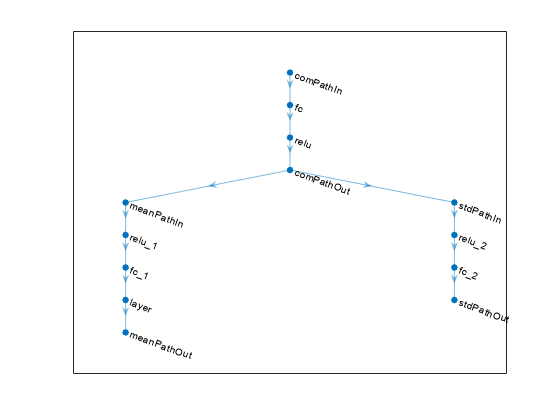
Initialize network and display number of weights.
actorNet = initialize(actorNet); summary(actorNet)
Initialized: true
Number of learnables: 595
Inputs:
1 'comPathIn' 2 features
Create the actor approximator object using actorNet and the environment specifications. For more information, on continuous Gaussian actors, see rlContinuousGaussianActor.
actor = rlContinuousGaussianActor(actorNet, obsInfo, actInfo, ... "ActionMeanOutputNames","meanPathOut",... "ActionStandardDeviationOutputNames","stdPathOut",... ObservationInputNames="comPathIn");
Check the actor with a random observation input.
getAction(actor,{rand(obsInfo.Dimension)})ans = 1×1 cell array
{[0.2732]}
Create a TRPO agent using the actor and the critic.
agent = rlTRPOAgent(actor,critic)
agent =
rlTRPOAgent with properties:
AgentOptions: [1×1 rl.option.rlTRPOAgentOptions]
UseExplorationPolicy: 1
ObservationInfo: [1×1 rl.util.rlNumericSpec]
ActionInfo: [1×1 rl.util.rlNumericSpec]
SampleTime: 1
Specify agent options, including training options for the actor and the critic.
agent.AgentOptions.ExperienceHorizon = 1024; agent.AgentOptions.DiscountFactor = 0.95; agent.AgentOptions.CriticOptimizerOptions.LearnRate = 8e-3; agent.AgentOptions.CriticOptimizerOptions.GradientThreshold = 1;
Check your agent with a random observation input.
getAction(agent,{rand(obsInfo.Dimension)})ans = 1×1 cell array
{[-0.5005]}
You can now test and train the agent within the environment.
TRPO agents do not support actors or critics that use recurrent networks, custom basis functions, or tables. You can, however, avoid these limitations by creating a custom layer for your network. To illustrate this possibility, this example shows how to solve the grid world environment shown in Train Reinforcement Learning Agent in Basic Grid World using a TRPO agent in which both the actor and the critic use a deep network that uses a custom layer that emulates a table model.
The example code might involve computation of random numbers at various stages. Fixing the random number stream at the beginning of various sections in the example code preserves the random number sequence in the section every time you run it, and increases the likelihood of reproducing the results. For more information, see Results Reproducibility.
Fix the random number stream with seed zero and random number algorithm Mersenne Twister. For more information on controlling the seed used for random number generation, see rng.
previousRngState = rng(0,"twister")previousRngState = struct with fields:
Type: 'twister'
Seed: 0
State: [625×1 uint32]
The output previousRngState is a structure that contains information about the previous state of the stream. You will restore the state at the end of the example.
Create Grid World Environment
The grid world environment has the following configuration and rules:
The grid world is 5-by-5 and bounded by borders, with four possible actions (North = 1, South = 2, East = 3, West = 4).
The agent begins from cell [2,1] (second row, first column).
The agent receives a reward +10 if it reaches the terminal state at cell [5,5] (blue).
The environment contains a special jump from cell [2,4] to cell [4,4] with a reward of +5.
The agent is blocked by obstacles (black cells).
All other actions result in –1 reward.
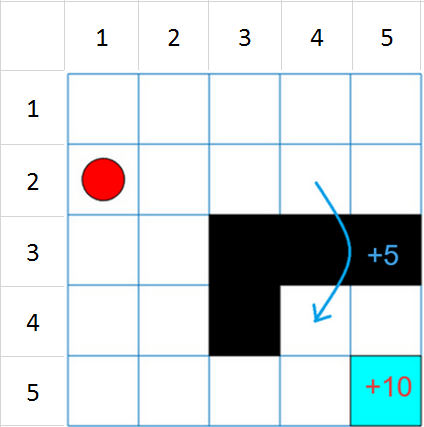

Create the basic grid world environment.
env = rlPredefinedEnv("BasicGridWorld");To specify that the initial state of the agent is always [2,1], create a reset function that returns the state number for the initial agent state. This function is called at the start of each training episode and simulation. States are numbered starting at position [1,1]. The state number increases as you move down the first column and then down each subsequent column. Therefore, create an anonymous function handle that sets the initial state to 2.
env.ResetFcn = @() 2;
Extract the observation and action specifications.
obsInfo=getObservationInfo(env); actInfo=getActionInfo(env);
Extract the number of possible observations and actions.
nObs=numel(obsInfo.Elements); nAct=numel(actInfo.Elements);
Fix the random generator seed for reproducibility.
rng(0)
Create Actor
To create the TRPO agent, first create a discrete categorical actor in which the approximation model is a neural network that mimics a table. First, create the initial table.
ActTable0 = 1+4*rand(nObs,nAct);
The custom one-hot layer myOHLayerV is implemented in the file myOHLayerV.m. Its input is a scalar ranging from 1 to numel(obsInfo.Elements). The output of the custom layer is a vector of dimension numel(obsInfo.Elements) in which the element corresponding to the value at the input of the layer is equal to 1, while all the other elements are equal to zero.
The layer constructor function takes as input the number of observation and stores it in its n property. The predict function takes as second argument the output of the previous layer, featureInputLayer(1). This is the dlarray X, which is a row vector having as many elements as the number of sequential observations in the batch, nbtc. It then creates a zero dlarray Z with as many rows as the number of possible observations (stored in its n property) and as many columns as the number of sequential observations in the batch, nbtc. The loop then cycles through each column of Z and sets its X(k) element to 1. For example, if the 42th observation in the batch is 13, then X(42)=13, and Z(13,42) is set to 1.
For more information on custom layers, see Define Custom Deep Learning Layers.
type myOHLayerVclassdef myOHLayerV < nnet.layer.Layer
properties
n
end
methods
function obj = myOHLayerV(outsize)
obj.Description = "One Hot Layer for Value Fcn";
obj.n = outsize;
end
function Z = predict(obj, X)
nbtc = size(X,2);
Z = dlarray(zeros(obj.n,nbtc));
for k = 1:nbtc
if X(1,k)
Z(X(1,k),k) = 1;
end
end
end
end
end
Create the actor network as a vector of layer object. The feature input layer inputs the feature data to the network. The last fully connected layer maps the output of myOHLayerV (a vector in which the element equal to 1 corresponds to the current observation) to the action number. Set the initial value of the fully connected layer weights to the initial table. Also, set the bias and its learning rate to zero.
anet = [
featureInputLayer(1)
myOHLayerV(nObs)
fullyConnectedLayer( ...
nAct, ...
Weights=ActTable0', ...
Bias=zeros(nAct,1), ...
BiasLearnRateFactor=0)
];Convert to dlnetwork.
anet = dlnetwork(anet);
Create the actor.
actor = rlDiscreteCategoricalActor(anet,obsInfo,actInfo);
Check the actor using a random input observation.
getAction(actor,{randi(nObs)})ans = 1×1 cell array
{[4]}
Create Critic
Create a value function critic in which the approximation model is a neural network that mimics a table. First, create the initial table.
ValTable0 = rand(nObs,1);
Create the critic network as a vector of layer object. The last fully connected layer maps the output of myOHLayerV to the estimated value of the policy.
cnet = [
featureInputLayer(1)
myOHLayerV(nObs)
fullyConnectedLayer( ...
1, ...
Weights = ValTable0', ...
Bias=0, ...
BiasLearnRateFactor=0)
];Convert to dlnetwork.
cnet = dlnetwork(cnet);
Create the critic.
critic = rlValueFunction(cnet,obsInfo);
Check the critic using a random input observation.
getValue(critic,{randi(nObs)})ans = single
0.0838
Create Agent
Create the agent using the actor and the critic.
agent = rlTRPOAgent(actor,critic);
Train Agent
To train the agent, first specify the training options. For this example, use the following options:
Train for a maximum of 200 episodes. Specify that each episode lasts for most 50 time steps.
Stop training when the agent receives an average cumulative reward greater than 10 over 30 consecutive episodes.
For more information on training options, see rlTrainingOptions.
trainOpts = rlTrainingOptions;
trainOpts.MaxStepsPerEpisode = 50;
trainOpts.MaxEpisodes= 2000;
trainOpts.StopTrainingCriteria = "AverageReward";
trainOpts.StopTrainingValue = 11;
trainOpts.ScoreAveragingWindowLength = 30;Train the agent. Training can take several minutes to complete. To save time while running this example, load a pretrained agent by setting doTraining to false. To train the agent yourself, set doTraining to true.
doTraining =false; if doTraining % Train the agent. trainingStats = train(agent,env,trainOpts); else % Load the pretrained agent for the example. load("trpoGWQAgent.mat","agent") end
The Reinforcement Learning Training Monitor window opens and displays the training progress.
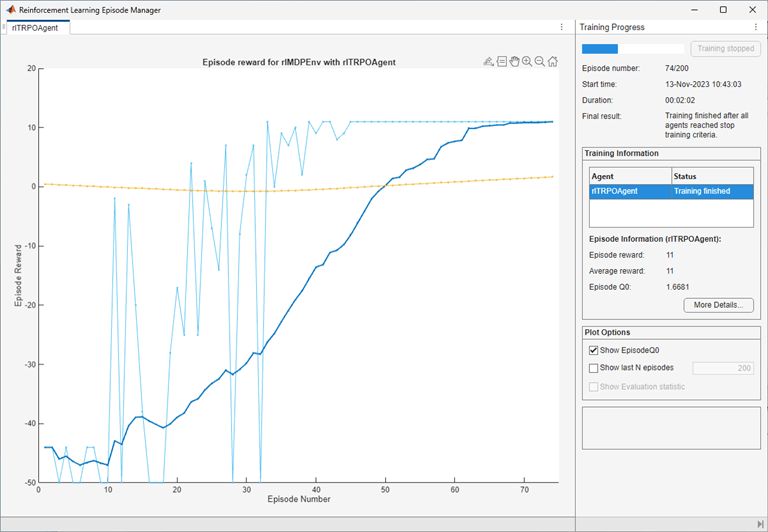
Validate Q-Learning Results
To validate the training results, simulate the agent in the training environment.
Before running the simulation, visualize the environment and configure the visualization to maintain a trace of the agent states.
plot(env) env.Model.Viewer.ShowTrace = true; env.Model.Viewer.clearTrace;
Simulate the agent in the environment using the sim function.
sim(agent,env)
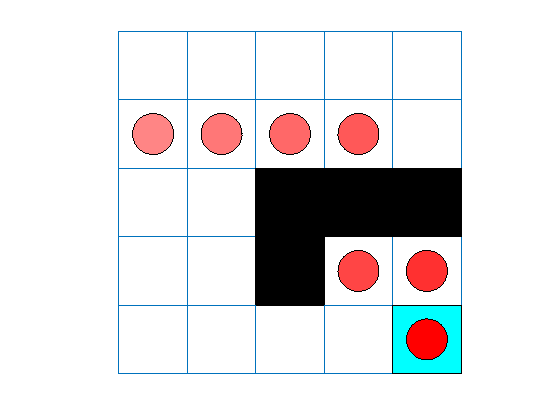
The agent trace shows that the agent successfully finds the jump from cell [2,4] to cell [4,4].
Restore the random number stream using the information stored in previousRngState.
rng(previousRngState);
Tips
For continuous action spaces, this agent does not enforce the constraints set by the action specification. In this case, you must enforce action space constraints within the environment.
While tuning the learning rate of the actor network is necessary for PPO agents, it is not necessary for TRPO agents.
For high-dimensional observations, such as for images, it is recommended to use PPO, SAC, or TD3 agents.
Version History
Introduced in R2021b
See Also
Apps
Functions
getAction|getActor|getCritic|getModel|generatePolicyFunction|generatePolicyBlock|getActionInfo|getObservationInfo
Objects
rlTRPOAgentOptions|rlAgentInitializationOptions|rlValueFunction|rlDiscreteCategoricalActor|rlContinuousGaussianActor|rlACAgent|rlPGAgent|rlPPOAgent
Blocks
MATLAB Command
You clicked a link that corresponds to this MATLAB command:
Run the command by entering it in the MATLAB Command Window. Web browsers do not support MATLAB commands.
Select a Web Site
Choose a web site to get translated content where available and see local events and offers. Based on your location, we recommend that you select: .
You can also select a web site from the following list
How to Get Best Site Performance
Select the China site (in Chinese or English) for best site performance. Other MathWorks country sites are not optimized for visits from your location.
Americas
- América Latina (Español)
- Canada (English)
- United States (English)
Europe
- Belgium (English)
- Denmark (English)
- Deutschland (Deutsch)
- España (Español)
- Finland (English)
- France (Français)
- Ireland (English)
- Italia (Italiano)
- Luxembourg (English)
- Netherlands (English)
- Norway (English)
- Österreich (Deutsch)
- Portugal (English)
- Sweden (English)
- Switzerland
- United Kingdom (English)